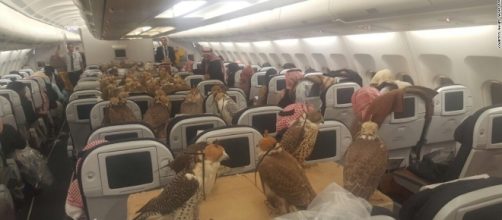Since several centuries ago, people hunted for food by training animals that would come after smaller creatures to retrieve for their handlers. Hunting animals ranged from dogs to birds of prey like Falcons. In the Middle East, especially in the United Arab Emirates, the practice of training falcons to swoop after prey has thrived even into the modern age, where it’s become less a hunting method and more in line with sports. While social mores have become more progressive in the UAE, some traditions haven’t changed, and the Emirati men who own falcons care very deeply for their birds.
After all, you must have a deep bond for the animal if you’d go so far as apply passports for them so they can sit with you on an aircraft cabin. I’m not kidding here, folks.
Flight for the birds
This week, one Ahmet Yasar uploaded a certain picture on Reddit, which was photographed and given to him by a friend who worked as a civilian pilot. It showed an aircraft cabin wherein the entire center section of seats have been reserved for the 80 hunting falcons owned by a travelling Saudi prince. Granted, as said before it’s not unusual to have Middle Eastern falconers taking their pets along with them on their seats, but the number of falcons seen in the picture was something else. Apparently the internet agreed as the photo went viral on social media, making the general online denizen more aware of the great care that falconers in the Middle East give for their birds.
The practice of keeping hunting falcons has been so ingrained in the consciousness of young men from the UAE that it’s been listed by UNESCO on their Intangible Cultural Heritage of Humanity. On the Emirati market, falcons can fetch prices anywhere from 2,000 dirhams ($544) to 70,000 dirhams ($19,058), depending on breed and ability. The UAE issues separate passports for an owner’s falcons (an anti-smuggling measure), with a record 28,000 such issued from 2002 to 2013.
Falcon passengers
So how exactly does taking falcons on a commercial flight work? It depends on the airline. Qatar Airways will allow an Economy passenger to carry one falcon with him, and only a maximum of six people with falcons on the Economy cabin per flight.
The UAE’s own Emirates would require cages for falcon passengers, but Royal Jordanian is more okay with them at liberty (and max 10-15 falcon-carrying passengers per flight depending on aircraft). Mind you, the birds get their own ticket prices to ride with their humans.
Is it safe for other passengers on Middle East flights to have birds of prey sitting close by? It’s really not so bothersome. Falcons are traditionally blindfolded with cowls to keep them from flying after anything they consider prey. With their eyes fully covered, a falcon will remain perfectly calm and still, perfect for keeping it controlled in long flights. They only get frisky when landing, but not by much.

